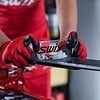Ski Wax Buyers Guide
At the Skihut we mainly carry Rex and Swix waxes and tools.
What's up with wax? These days - A LOT! But, before we get into any specifics, let's get the basic's down. There are basically two types of ski wax - grip wax (also called stick or kick wax) and glide wax.
Glide Wax
Glide wax is slippery. It comes in sprays, bricks, liquids, gels, and pastes. It is designed to enhance gliding while skiing either classic or skate technique when XC skiing or while snowboarding or downhill skiing. A skate ski requires that glide wax be applied to the entire length of the ski base - same as with Alpine (downhill) skis or snowboards. The bases on all three are all full-on glide surfaces. The less abrasive (usually warmer) the snow being skied on - the softer the wax should be. The more abrasive (usually colder) the snow being skied on - the harder the wax should be.
Glide waxing has traditionally been limited to hot-waxing (melting the wax onto the ski with a waxing iron) for most performance-minded skiers, and paste or liquid waxing for most recreational skiers. That has changed a bit over the last few years as liquid waxes have improved exponentially! New liquid waxes from Rex, Swix, or any reputable brand, are far faster and more durable than they have been in the past. And they are so much easier to apply! These new generation liquid glide waxes are now widely accepted in all forms of ski racing. Hot-waxing definitely still has its place. But it is no longer the only game in town.
Grip Wax
Grip, stick, or kick wax is sticky. It comes in small round tins, tubes, spray cans, or liquid applicators. It is designed to stick to the snow in order to provide grip. This grip propels the skier forward when they “kick” the ski. Grip wax is used when classic XC skiing only. The warmer the snow it is intended to be used on - the stickier grip wax is. The colder the snow it is intended to be used on - the harder the wax will be. Grip wax should never be applied to a skate ski, snowboard, or downhill ski. Never. Never ever. No. Don’t do it. Ever.
You’ve likely picked up on the fact that classic XC skis require BOTH grip and glide wax. How the heck does that work? Easy - sort of. The base of a classic ski is roughly divided into thirds (the lengths of each third is highly variable depending on how a specific skier’s weight affects a specific ski's flex - TMI for now). The front third is a glide surface requiring glide wax. The middle third is the grip zone requiring grip wax. The last third is, again, a glide surface requiring glide wax.
Grip-waxes still primarily come in small tins that need to be peeled down as the wax is used. But there are easier to use liquids that meet the needs of most recreational grip-waxers. Klister (exceptionally sticky grip wax that traditionally has come in tubes) has changed a bit as well as new liquid versions are less messy and easier to apply. And, they go on thin! So you don’t need a super-high camber to accommodate a fairly long application. They are, however, still a bit of a pain to remove.
Geez...That Sounds Confusing.
This may be what you are thinking after reading the intro. And, yes, waxing can be very confusing. But it doesn’t have to be. If you are hoping to be, or are, a competitive racer you will likely go pretty far down the waxing rabbit hole (slurries, cushion, overlays, roto-brushing, and covers will become part of your daily vocabulary). Some people even find complex waxing to be relaxing and enjoyable - to each their own. But for most skiers waxing can be very easy! No joke. These days the average skier can get by with one or two really good and effective grip waxes and one - that’s right - one glide wax. Application processes are easy! Sprays and liquids are revolutionizing the sport. Grip wax removal can take some work. But, if you utilize good skiing practices, you won’t need to remove grip wax as often. Don’t be intimidated by your racer friends. You can wax your skis and you can do it quickly and easily! For real.
What About Waxless?
Waxless skis are better than they have ever been! In fact, some of today’s waxless skis can be as fast and have as good of grip as a waxable ski. No joke. However, notice we said “can be”. If conditions are just right, a waxless ski can be amazing. But, usually, they just don’t quite compare to a perfectly waxed ski. Notice we said “perfectly waxed”. There is a lot of gray area here.
The term “waxless” is a bit of a misnomer. Waxless refers to a ski that does not require grip wax. Every “waxless” ski requires some form of glide wax at times. Some waxless skis have glide zones that are just as high quality as a race ski. They require wax to retain their glide speed. Others simply need a liquid or paste wax applied only when the snow is actually wet. Especially if that wet snow is fresh-fallen. In these conditions, without a touch of wax, the ski simply will not glide. At all.
Skate skis are not waxless. If they are not waxed they will get slower every season. You have to wax a skate ski if you want it to work well.
To Wax or Not To Wax.
That is, indeed, the question. How do you get it answered? Go to a good ski shop! Any good XC ski shop will talk you through the entire process of caring for your skis. They will give you the easy, cheap, complex, and expensive options. They will also have wax clinics designed to shine a light on all of these options. We can’t say it enough - get to know your local shop if you have one. They are there to help you.


 Shop
Shop
 Service & Repair
Service & Repair
 38th Annual Ski Hut Bozeman Trip
38th Annual Ski Hut Bozeman Trip
 Wax Clinics
Wax Clinics
 Ski Hut Blog
Ski Hut Blog
